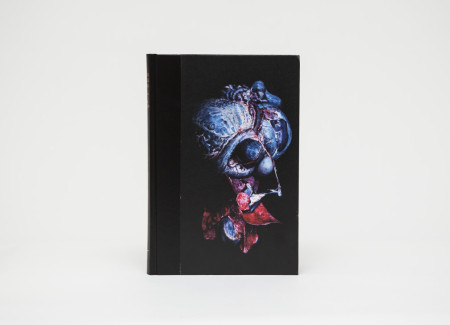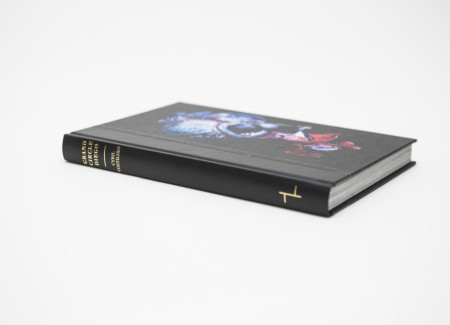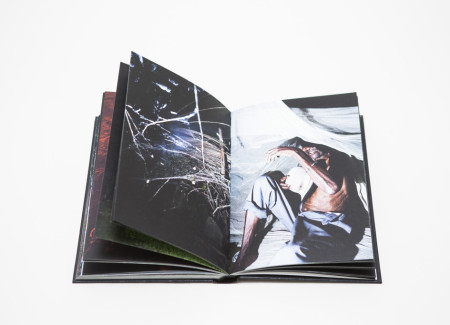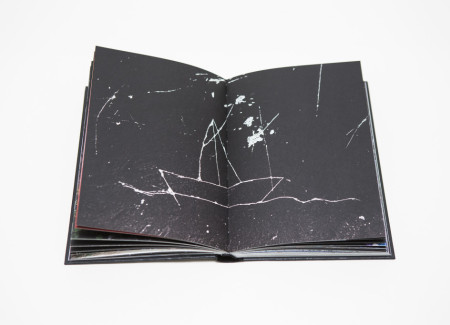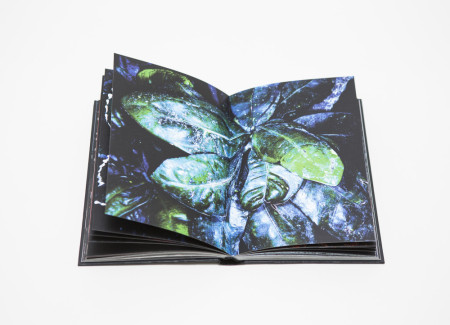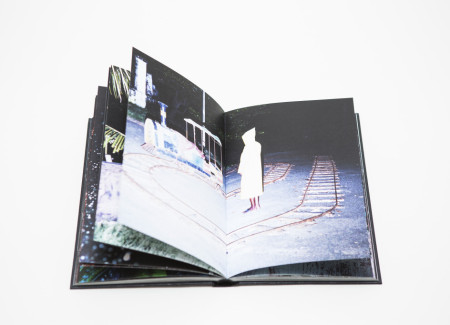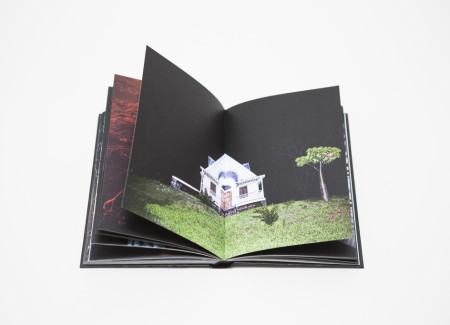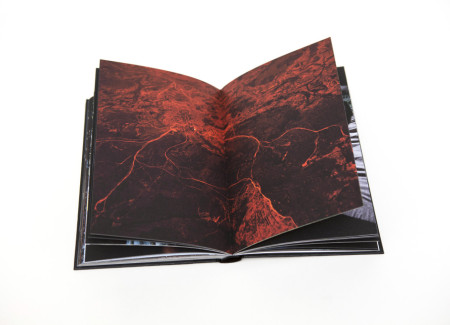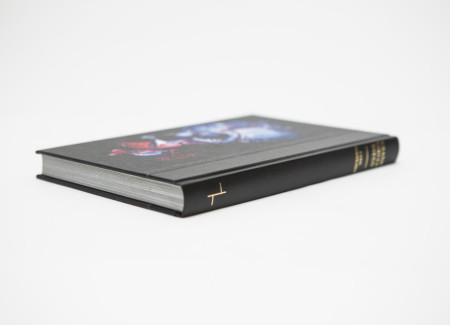JTF (just the facts): Published in the fall of 2014 by Akina Books (here). Hardcover quarterbound leatherette, 144 pages, with 81 color reproductions. Includes a text by the artist. Edition of 800 copies. (Spread shots below.) Grand Circle Diego is also available in a special edition (here). This includes a copy of the book with a c-print (numbered and signed, 8 x 10 inch, on metallic paper) in an edition of 40.
Comments/Context: Grand Circle Diego is the first photobook by French photographer Cyril Costilhes. Densely black and haunting, it is a highly personal book, the result of a very intimate journey, an inward search for oneself.
The dominance of rich black color is the first thing that catches your eye – the contrast in the color images is very strong, the blacks lush and deep. With the text placed at the very end (forcing us to first flip through the book before getting any back story), we’re led through a desperate parade of shadowy images, shot with a direct flash and often overexposed. Almost all the photographs have intentional vignetting, forming black layer at the periphery; it creates a visual tunnel, reinforcing the feeling of the unknown, of uncertainty and loss. What exactly is happening (or has happened) here?
At the end of the book, in what looks like three diary notes, Costilhes gives us a few clues to help to reconstruct the narrative. Costilhes’ father moved to Diego Suarez, in the far north of Madagascar, where he opened a casino business, looking for paradise and beautiful young women. His expatriate dreams came to an abrupt end as a motorcycle accident left him with heavy front lobe dementia; he was taken back to France and has been in a coma ever since (over eleven years now). Costilhes’ writing is very personal as he envisions the last moments before the crash and the nightmare that followed – it’s as if he is talking directly to his father.
Costilhes ultimately travels to Madagascar, in search of a better understanding of his father and his life, to comprehend the family tragedy. In his own words, “I have this crazy idea of transforming this suffocating situation into something positive, something that would give sense to all this. Turn the ugly into beautiful”. He uses his camera to deal with these personal experiences, feelings, and fears. Costilhes’ father was attracted by Madagascar’s idyllic blue water beaches and tropical weather, and he was seduced by the feeling of freedom and the illusion of power Westerners can often have on a postcolonial island. His son visits the location of the accident and steeps himself in the jungle surroundings; it’s a dark and painful experience. The book reveals a grim, traumatic nightmare, starkly juxtaposed with the idyllic paradise his father was chasing.
There are numerous shots of tree branches in the darkness, broken spider webs, and close ups of plants. Is this the crime scene? Captionless images hide more than they reveal. Their haunting, intense atmosphere carries the presence of Costilhes’ absent father. There are several shots of desolate looking houses. Did his father live there? One image is a close up of an elderly man’s face, his right eye is swollen, his gaze is full of sadness. Another shot depicts a standing body covered in white light fabric, just showing part of the face – the skin is dry and the eye doesn’t look alive. It is a human or a mummy? Images of anonymous women – nude, dressed up, feeding a baby – add a sweaty layer of erotic intensity.
The book’s title, Grand Circle Diego, refers to the casino run by the father. Does Costilhes sees it as a cause and symbol of this tragedy? The book is a circle, with images of overexposed plants, lost houses, shadows, primitive looking drawings, crippled inhabitants, pools of blood and flesh repeating again and again, often in circular shapes. The same image appears on the front and back covers – an internal organ that resembles a flower, symbolizing this same life and death journey, maybe even a circle that can’t be broken. Is it a sign of no way out?
Elements of the book design, particularly its spine with text in gold and quarterbound leatherette, resemble the Bible, adding a layer of solemn religious symbolism. The layout of images is composed of full bleeds, most of them on double spreads, and the bookbinding technology allows the book to lay flat without much loss from the binding. Black pages at the beginning and the end of the book almost serve as a warning to the visualized nightmare that lurks beneath the covers.
Grand Circle Diego is a dark exploration of the photographer’s ghosts, and it powerfully captures Costilhes’ quest to reconnect with his father. Through its lavish printing, elemental design, and careful editing, the book creates the ambiance of very personal catharsis, leaving most of its mysteries unrevealed.
Collector’s POV: Cyril Costilhes does not appear to have gallery representation at this time. Collectors interested in following up should likely connect directly with the artist via his website (linked above).
